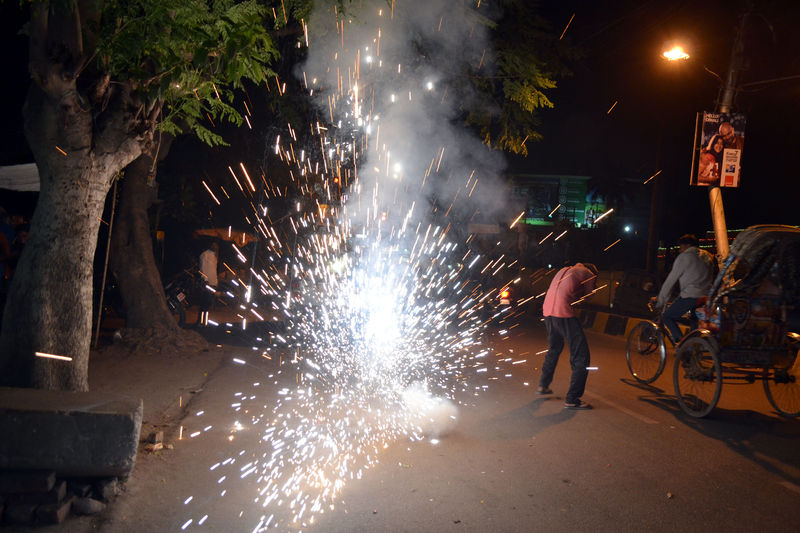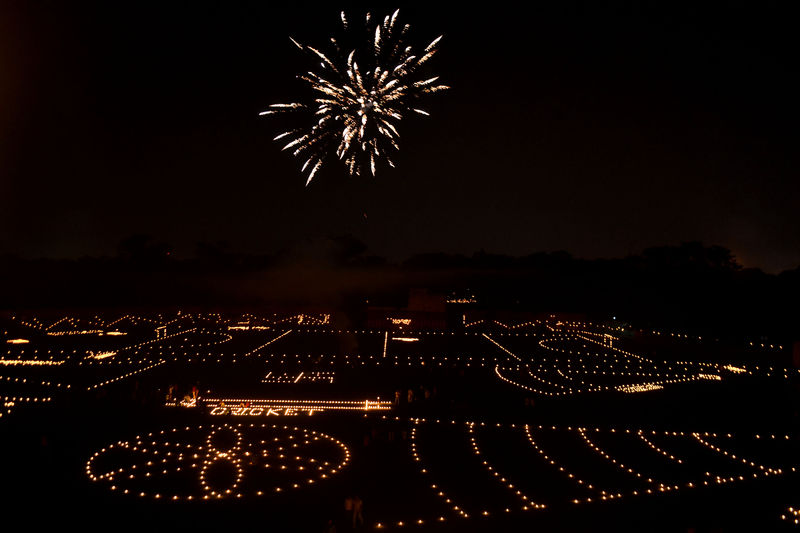
Indians light crackers to celebrate diwali, the festival of light on a busy road in Allahabad on October 23, 2014. Image by Ritesh Shukla. Copyright Demotix.
During Diwali (the Hindu “festival of lights”), people dress up in new clothes—sometimes their best outfits—and light up lamps and candles inside and outside their homes, participating in prayers and launching fireworks. It's a noisy affair that produces a lot of pollution.
Despite a sustained anti-firecracker campaign, calls for a more environmentally conscious Green Diwali, an attempt to crack down on Chinese fireworks, and a 10pm-curfew, Indians didn't stay away from pyrotechnics anymore this year than last. As a result, the holiday once again made breathing difficult across the nation.
For years, India has discussed efforts to make the country's top cities as globally appealing as China's metropolises. For the next few days, India will actually obtain parity with China's biggest cities: in pollution levels! not urban efficiency or infrastructural sophistication. Thanks to Diwali, sound and air pollution in India has reached alarming levels.
On Twitter, Indians have issued public appeals to reduce pollution on Diwali:
Let's celebrate Green Diwali …Join Human Chain with @AAPYouthwing at CP by 4PM Today & Say no to crackers pic.twitter.com/CtrKqfxWpq
— Kumar Amit (@Ikumar7) October 19, 2014
Diwali in India will not be noise and pollution free till we inculcate a sense of belonging,sense of ownership+concern & respect for others
— Kiran Bedi (@thekiranbedi) October 24, 2014
Have a safe and noise-free Diwali. Reduce sound and pollution. Focus on the lights. pic.twitter.com/RxU2XvTs7s
— Sneha Mahale (@randomcards) October 23, 2014
This Diwali, spread joy, not pollution. #HappyDiwali #NoPollution
— Gautam Singhania (@SinghaniaGautam) October 23, 2014
My darlings.It's my humble request 2 U'll to not burst any crackers this year..more noise n air pollution is nt required.have a safe diwali
— Pooja Hegde (@hegdepooja) October 22, 2014
More than 15K children are employed in making firecrackers. Try to Celebrate Green Diwali @AamAadmiParty pic.twitter.com/JcKwFs2GcS
— Aam Aadmi (@pramod7224) October 18, 2014
Of course, some people argue that it wouldn't be Diwali without the noise and smoke:
#ItsNotDiwaliUnless we Burst loads of Crackers and place a tight slap on the faces of Pseudo-Seculars who are campaigning Green Diwali
— Cassiopeia (@_shomy) October 22, 2014
According to reports, Delhi, Ahmedabad, and Chennai measured levels of toxic gases and materials in the air far above what's considered safe for breathing.
The festival started on Thursday, October 22, 2014. That evening, toxicity levels in the air spiked suddenly. According to the System of Air Quality Weather Forecasting and Research, the air in Delhi will be more polluted than Beijing's atmosphere for some days to come.
In one of the biggest states in India, Madhya Pradesh, pollution even seems to be affecting the weather. (The state's average temperatures spiked 1.3 degrees, thanks presumably to the massive amounts of smoke and other gases released into the air.) Due to an absence of winds, the smog left by fireworks is expected to remain in the air for another 48 hours.

Indian sportsmen lighten up the stadium with candles and fire works on the eve of Diwali in Allahabad on October 22, 2014. Image by Ritesh Shukla. Copyright Demotix.
In many areas in India, sound pollution has also been a serious problem. Mumbai, for example, has struggled with noise levels above 80dB.
Diwali's environmental impact doesn't end with bad air and loud noises, either. In Chennai, celebrations created 27 tons of waste from firecrackers—a whooping 17 tons more than in 2013. Despite continued calls for a “Green Diwali” by the Industrial Waste Management Association, the holiday continues to produce growing amounts of trash, posing a greater problem every year for India's Common Hazardous Waste Treatment Storage and Disposal Facility.
What prevents Indians from addressing the environmental damages inflicted by Diwali? Is it that the public is simply ignorant about the threats to their own health and safety?
The Indian public, however, may be getting wise. Some encouraging data suggests that people are changing the way they celebrate Diwali. Several regions in Mumbai, Madhya Pradesh, and Pune recorded pollution levels this year that are actually lower than in previous years. While toxicity is still higher than doctors recommend, the data indicates that awareness campaigns in schools are finally making a difference. Indeed, firecracker manufacturers reported falling sales this year (down by 60-70 percent!)—a drastic decline, and welcome news for India's environmentalists.

Earthen oil lamps outside a house in Delhi during Diwali celebrations. Image by Prabhjot Kaur. Copyright Demotix (2/11/2013)
In a bid to make Diwai more eco-friendly, New Delhi markets and even online stores are now selling a new line of products for “responsible citizens”—goods like upcycled candle moulds rangoli-inspired bamboo trays and sandstone diyas.
Here's hoping environmental awareness continues to spread in India and alternative celebrations catch on!






